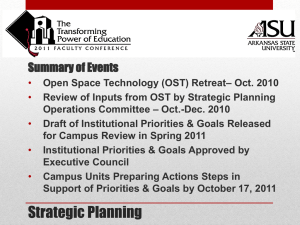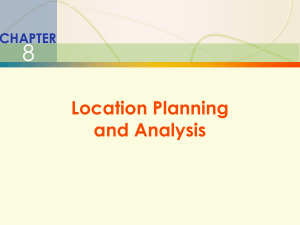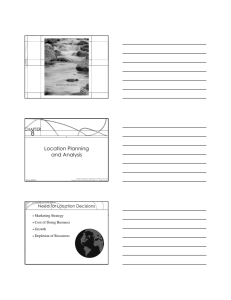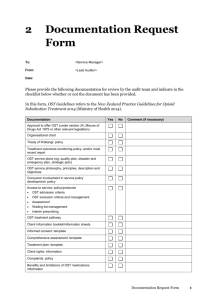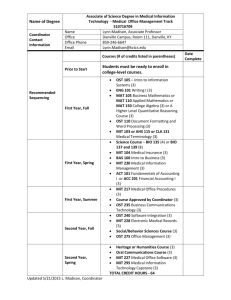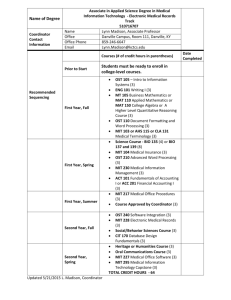Powerpoint - AIDS 2014 - Programme-at-a
advertisement
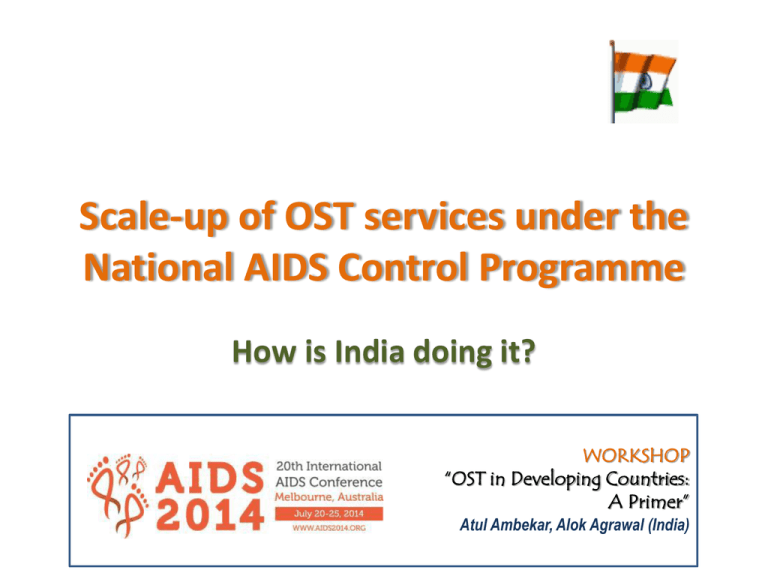
Scale-up of OST services under the National AIDS Control Programme How is India doing it? WORKSHOP “OST in Developing Countries: A Primer” Atul Ambekar, Alok Agrawal (India) Contents Background: PWID-HIV situation in India OST service delivery models Capacity Building, Monitoring and Quality Assurance of OST PWID – HIV situation in India • Estimated PWID ~ 200,000 ~ 95% male ~ 8% living with HIV • Heterogeneity of epidemic – ‘Old’ versus ‘New’ epidemics – Drugs injected: Heroin / Brown Sugar; Buprenorphine, Pentazocine, Dpropoxyphene – Wide variations in seropositivity (1% to 50%) OST in India • Buprenorphine for treatment of Opioid dependence – In existence since 1989 – At a smaller scale • OST as HIV prevention intervention for PWID – Since 2007 – Undergoing scale–up OST scale-up in India - Buprenorphine Number of OST centres Number of PWID on OST 15000 16000 14000 140 12000 120 10000 100 8000 80 6000 60 4000 3000 51 40 2000 20 0 0 Year 2007-10 150 160 Year 2014 Year 2007-10 Year 2014 OST scale-up in India - Methadone • Initiated as a Pilot Project – 2012 – 5 sites, all government hospitals – About 600 PWID initiated on Methadone – On the verge of scale-up 2010: The Watershed year • Introduction of new model of OST service delivery OST services Other Health services HOSPITAL NGO NSEP and other Harm reduction services PWID Outreach worker from NGO takes PWID to the OST center in govt. hospital HOSPITAL with OST NGO NSEP and other Harm reduction services PWID Mechanisms for building capacities and ensuring quality Capacity Building 1. Induction Training 2. Quality Assurance / Mentoring 3. Accreditation Evaluation Mechanisms for building capacities and ensuring quality Capacity Building 1. Induction Training 2. Quality Assurance / Mentoring 3. Accreditation Evaluation Induction Training on OST 0 A five day training programme 0 Conducted soon after recruitment of staff 0 Conducted for a mixed group of staff (nodal officers, doctors, nurses, counselors, data managers, programme managers and outreach workers) 0 Class-room type training 0 Highly interactive and participatory 0 Exposure visit – an essential component 0 BASED UPON A MANUAL 0 Outcome: 0 Trained staff who begin service delivery after receiving a certificate Mechanisms for building capacities and ensuring quality Capacity Building 1. Induction Training 2. Quality Assurance / Mentoring 3. Accreditation Evaluation Quality Assurance of OST 0 In the form of ‘visits’ by OST experts / mentors 0 Visits aimed at: 0 Assessment of the quality of services 0 Interaction with and guidance to the staff on ensuring adequate quality 0 Mentors / experts: Doctors; experience / expertise in OST; trained on QA guide 0 Outcome: Staff receives hands-on guidance; SACS / NACO receive a report on performance Quality Assurance of OST 0 In the form of ‘visits’ by OST experts / mentors 0 Visits aimed at: 0 Assessment of the quality of services 0 Interaction with and guidance to the staff on ensuring adequate quality 0 Mentors / experts: Doctors; experience / expertise in OST; trained on QA guide 0 Outcome: Staff receives hands-on guidance; SACS / NACO receive a report on performance Atul Ambekar, Ravindra Rao, Alok Agrawal, Anju Dhawan, Rajat Ray, (2013), Quality Assurance of OST in India: A reference guide for mentors, NDDTC, AIIMS and NACO, Government of India, New Delhi QA Guide: Contents 0 Introduction / About the Reference Guide 0 Conducting a Quality Assurance Visit 0 Preparing a Quality Assurance Visit Report 0 Tool for OST Quality Assurance Visit 0 OST Quality Assurance Visit Report - Proforma 0 Annexures: List of common problems and their solutions; Steps for Planning and Managing QA Visits, Conducting a QA visit 0 Inform the centre staff and concerned SACS prior to visit 0 During visit 0 Observation of the centre, including functioning of the staff and service delivery processes 0 Review of records 0 Interaction with 0 Staff – OST centre 0 Staff – linked IDU TI 0 Beneficiaries 0 Other stakeholders 0 Use the prescribed format to conduct the visit 0 Use the prescribed format to report the visit Tool for OST quality assurance visit Tool for OST quality assurance visit Section 1: Background information Section 2: Details of the OST centre Section 3: Staff-related Details Section 4: Implementation Of OST Section 5: Record Keeping-related Details Section 6: Feedback from Clients and their Families Section 7: Stock Maintenance & Programme Management Section 8: Gaps Identified and Addressed Section 9: Impression on Quality of OST Centre Impression on Quality of OST centre 0 16 - item scoring scale 0 Each item can be scored 1, 2 or 3 0 Option for giving remarks for each item 0 Quality grading depends upon the total % score obtained Impression on Quality of OST centre Item 1: OST uptake Item 2: Recruitment and training of staff Item 3: Knowledge and confidence of staff on OST issues Item 4: Role clarity Item 5:Initial assessment of clients before OST initiation Item 6: Stabilisation dose of buprenorphine Item 7:Follow-up of OST clients Item 8:Changes in dose of buprenorphine Impression on Quality of OST centre Item 9:Duration of maintenance phase of treatment Item 10:Follow-up of LFU/irregular clients in the field Item 11:Dispensing-related protocols Item 12:Record maintenance Item 13:Stock management Item 14:Satisfaction of clients and family members Item 15:Client retention Item 16: Treatment adherence and compliance OST Quality Assurance visit report 0 Observations/findings and specific recommendations on specific areas of OST implementation 0 Other specific inputs provided 0 Issues for consideration by programme authorities Annexures 0 List of common problems and possible solutions 0 Planning and managing the OST QA visits Mechanisms for building capacities and ensuring quality 1. Induction Training 2. Quality Assurance / Mentoring 3. Accreditation Accreditation 0 All NGO OST centres expected to undergo Accreditation 0 Accreditation for Government centres also on the anvil 0 Conducted by an independent agency: National Accreditation Board for Hospitals (NABH) 0 Through trained team of two experts (Technical + Programme) 0 Using a especially prepared tool 0 Report provides 0 Scores 0 Qualitative / descriptive information Accreditation 0 All NGO OST centres expected to undergo Accreditation 0 Accreditation for Government centres also on the anvil 0 Conducted by an independent agency: National Accreditation Board for Hospitals (NABH) 0 Through trained team of two experts (Technical + Programme) 0 Using a especially prepared tool 0 Report provides 0 Scores 0 Qualitative / descriptive information The Accreditation Tool 0 In the form of an excel sheet 0 Filled by both the experts through observations and interaction The Accreditation Tool 0 In the form of an excel sheet 0 Filled by both the experts through observations and interaction 0 Sections 0 Infrastructure 0 Staff 0 Service Delivery Process 0 Performance 0 Qualitative information 0 “Essential Items” Accreditation: Essential items Infrastructure Staff OST Service Delivery Processes Storage of Medications Doctor OST Nurse Regularity of functioning Adherence to DOTS Dosage Change Dispensing Records Stock records Mechanisms to check diversion Programme Performance Service utilization Resource Materials developed for Capacity Building and Quality Assurance 1. Training 2. SOPs Manual 3. Practice Guidelines 4. QA Guide

